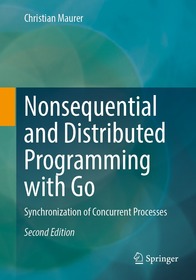
Nonsequential and Distributed Programming with Go
Synchronization of Concurrent Processes
- Publisher's listprice EUR 64.19
-
26 622 Ft (25 355 Ft + 5% VAT)
The price is estimated because at the time of ordering we do not know what conversion rates will apply to HUF / product currency when the book arrives. In case HUF is weaker, the price increases slightly, in case HUF is stronger, the price goes lower slightly.
- Discount 12% (cc. 3 195 Ft off)
- Discounted price 23 428 Ft (22 312 Ft + 5% VAT)
Subcribe now and take benefit of a favourable price.
Subscribe
26 622 Ft

Availability
printed on demand
Why don't you give exact delivery time?
Delivery time is estimated on our previous experiences. We give estimations only, because we order from outside Hungary, and the delivery time mainly depends on how quickly the publisher supplies the book. Faster or slower deliveries both happen, but we do our best to supply as quickly as possible.
Product details:
- Edition number 2
- Publisher Springer Fachmedien Wiesbaden
- Date of Publication 3 July 2025
- Number of Volumes 1 pieces, Book
- ISBN 9783662709283
- Binding Paperback
- No. of pages424 pages
- Size 240x168 mm
- Language English
- Illustrations XX, 424 p. 35 illus., 3 illus. in color. Illustrations, black & white 675
Categories
Long description:
"
After a short chapter on basic aspects of software engineering and its realization in Go, this book introduces to nonsequential and distributed programming with Go. It systematically presents basic concepts for the synchronization and communication of concurrent processes. These include locks, semaphores, fairness and deadlocks, monitors, local and network-wide message passing, networks as graphs, network exploration, distributed depth and breadth first search, and the selection of a leader in networks. In order to make readers familiar with the concepts, the author always takes up the same classic examples. This makes learning easier, because the concepts presented can be compared more easily with the language resources.
The algorithms are formulated in the Go programming language, which can be used to express numerous synchronization concepts. Due to its simple syntax, Go also offers the advantage that readers without prior knowledge can follow the basic concepts. The chapters on locks, semaphores, monitors and network-wide message passing also present some basic approaches to programming in C and Java. All source texts are available online.
Besides a number of error corrections and smaller updates, in this second edition the nanouniverse nU is replaced with the microuniverse μU. This allows for beautiful animations in many places, which are not possible with the nanouniverse due to a lack of the necessary support for inputs and outputs; e.g. in the chapters on fairness, messages, farMonitors, traversals and election.
" MoreTable of Contents:
Introduction.- Packages, Interfaces and Abstract Datatypes - Locks - Semaphores.- The Baton Algorithm.- Universal Critical Sections.- Fairness.- Deadlocks.- Monitors - Universal Monitors.- Message Passing.- Comparison of the Previous Language Constructs.- Netwide Message Passing.- Universal Far Monitors.- Networks as Graphs.- Heartbeat Algorithms.- Traversing Algorithms.- Leader Election Algorithms.
More



